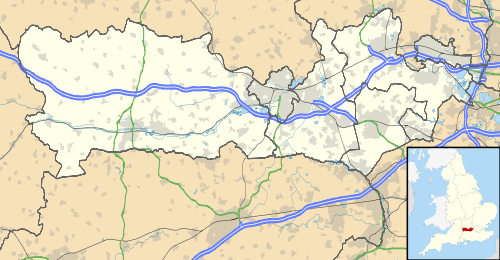Pest Infestation Control Laboratory
| Pest Infestation Control Laboratory[1] | |
|---|---|
 Location within Berkshire | |
| Former names | Pest Infestation Laboratory |
| Alternative names | Slough Laboratory |
| General information | |
| Type | Entomology Research Centre |
| Address | London Road, Upton, Slough, SL3 7HJ |
| Coordinates | 51°30′11″N 0°34′13″W / 51.503°N 0.5702°W |
| Elevation | 25 m (82 ft) |
| Current tenants | Housing estate |
| Completed | 1929 |
| Owner | Department of Scientific and Industrial Research |
The Pest Infestation Control Laboratory was a government-run laboratory in Slough during the war investigating food security.
History
In the late 1930s the Grain Infestation Survey Committee was set up, which in December 1938 decided that a dedicated research establishment was needed.
It was set up at a biological field station of Imperial College of Science and Technology (ICST) in Slough on 1 April 1940 by the Department of Scientific and Industrial Research which took the field station into its ownership during the war; the field station had been established in 1929 on the Hurworth Estate; it was Imperial College's first field station, one mile east of Slough.[2] Earlier pest research had gained the interest of the Empire Marketing Board. National food security in wartime took a high priority.
After the war, some staff moved to Silwood Park, which is the rural campus of Imperial College, where work was carried out on chemical insecticides.
In February 1984, the government set up the Crops Protection Committee, which later found that up to 10% of stored grain was at risk from pest infestation.[3] Fumigation was the most popular way to eradicate pests.
Function
It carried out research on attacks by fungal and insect pests on harvested crops, to help farmers implement pest control strategies. The laboratory studied the life history, habits and physiology of pests (mainly insects). Insecticides that would limit insect population, or eradicate them, were studied, such as by fumigation. It worked largely with biologists and chemists at Imperial College, including the zoologists Octavius Lubatti and Albert Page.
In the 1980s it carried out research on the indestructible Pharaoh ant, by looking at analogue hormones.
Structure
The main site was at the Slough Biological Field Station, partly run by the Ministry of Food. The Infestation Control Division was built at Tolworth.
See also
- Forest Products Research Laboratory, set up in 1923 by the Department of Scientific and Industrial Research to investigate wood pests
